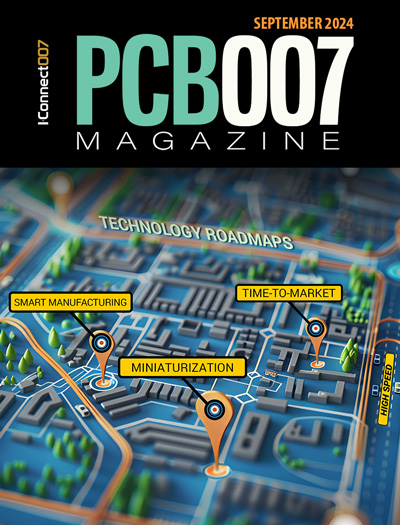-

- News
- Books
Featured Books
- pcb007 Magazine
Latest Issues
Current Issue
Engineering Economics
The real cost to manufacture a PCB encompasses everything that goes into making the product: the materials and other value-added supplies, machine and personnel costs, and most importantly, your quality. A hard look at real costs seems wholly appropriate.

Alternate Metallization Processes
Traditional electroless copper and electroless copper immersion gold have been primary PCB plating methods for decades. But alternative plating metals and processes have been introduced over the past few years as miniaturization and advanced packaging continue to develop.

Technology Roadmaps
In this issue of PCB007 Magazine, we discuss technology roadmaps and what they mean for our businesses, providing context to the all-important question: What is my company’s technology roadmap?
- Articles
- Columns
Search Console
- Links
- Media kit
||| MENU - pcb007 Magazine
Estimated reading time: 4 minutes
Global Sourcing: The 5 Cs of Choosing the Right PCB Supplier
Global sourcing is a complex process and choosing a supplier is always an important decision. The higher the technology, the more important the process for choosing the right one. Considering the highly complicated process of manufacturing printed circuit boards, these guidelines will assist in your decision.
1. Communication
Establishing an open line of communication with any supplier is certainly important, but when working with a PCB manufacturer, it becomes mission critical. Effective two-way communication is at the heart of any strong business relationship. If you don’t talk to your suppliers, you won’t learn enough about them to build these relationships. Looking at all the various commodities within the electronics industry, the one with the most opportunities for failure is PCBs. Early engagement between the PCB fabricator and customer is critical during the initial stages of a new product launch. Technical questions are always part of the communication process and a breakdown at this stage will create delays and put product reliability at risk. Accessibility to a direct line of communication between both sides will avoid these concerns. However, this communication does not stop at the engineering door; it must continue throughout the PCB manufacturing process. A supplier that provides real-time order updates will minimize the impact to the customer. Keep in mind that the equation gets more complicated when working with an offshore supplier because the communication channel must bridge time-zone and language challenges.
2. Collaboration
Before selecting a global PCB supplier, it’s important to understand if the company has the internal capability and strategy alignment to make the relationship a success. Under-investing in this due diligence is one of the top reason’s supplier collaborations fail. The right supplier needs to have the capability to meet the customers’ current technological needs, and the ability to anticipate and develop additional technology to meet future needs. One benefit of strong supplier/customer collaboration is the understanding of what the PCBs supplied will be used for and what causes problems in the final product. Going back to the earlier point of communication, another key benefit of collaboration is the reduction of quality issues due to early design engagement. Perhaps the most important benefit of collaboration for the customer is cost reduction. Design for manufacturability (DFM), alternate material suggestions, and minimizing over-engineered designs will result in hard savings and avoided delivery delays.
3. Credibility
PCB manufacturing is engineering intensive and requires operational process excellence. One thing to look for is strong engineering expertise and a solid industry reputation for product quality in the technology you are going to be placing with the supplier. A proven track record on delivery, quality, and flexibility are good starting points. Looking at who else they do business with is another strong indicator of the supplier’s credibility. Other customers in the same market sector as you will provide confidence that the supplier understands the intricacies and idiosyncrasies of your business and meets them on a daily basis. Credibility is all about building trust, and trust with your supplier relationships is crucial for achieving supply chain excellence. Another aspect of credibility is whether the supplier is authentic; in other words, do they do what they say? When your PCB supplier give you a delivery date, you need to be highly confident that they are going to meet it. The same confidence must also apply to product quality; and since PCBs are the backbone of any electronic product, failure is not an option.
4. Complete PCB Solution
When choosing a global PCB supplier, it is infinitely more beneficial to select a supplier that can build as much of your technological requirements as possible. In the world of PCB sourcing, not following this model can quickly result in an explosion in the number of suppliers you will need and have to manage. While no supplier is a one-stop shop, minimizing the number of suppliers in your supply base will also minimize your supply chain costs. Technology, surface finish, layer count, and substrate materials are some of the variables that must be considered when assessing a potential PCB supplier’s capability. In addition, product-type capability must be evaluated, such as rigid, rigid-flex, radio-frequency (RF), and metal core PCBs. Covering all of your requirements with the fewest suppliers will pay dividends in both qualification costs and the cost of ongoing supplier management.
5. Continuity
One of the biggest supply-chain risks is continuity of supply, and working with a supplier on another continent adds a multitude of logistical challenges to the mix. This is listed last because the previous four considerations can all impact supply continuity. Poor communication can result in delivery delays due to process issues or miscommunications. Finding out in mid-production that a supplier can’t build a particular part results from a lack of collaboration. A supplier that frequently reschedules promised delivery dates does not have the needed credibility to avoid supply disruptions. A supplier with below average engineering expertise is not a complete PCB solution. Assuming these four aspects are covered, there are some other things that can be done to minimize supply disruption. One thing to look for is a supplier that has multiple facilities so that if one is subject to a natural disaster, for example, your product can be temporarily moved to another plant. In some regions of the world, having an independent source of electricity is another critical factor to avoid supply delays. Finally, choose a supplier that has a formal business continuity plan in place.
The credibility and reputation of your company is based in part on your supply chain and you are only as good as your weakest link. Choose wisely.
Steve Williams is the president of The Right Approach Consulting.
This column originally appeared in the September 2018 issue of PCB007 Magazine.
More Columns from The Right Approach
The Right Approach: I Hear the Train A Comin'The Right Approach: Culture Change is Key to a QMS
The Right Approach: Leadership 101—Be a Heretic, Not a Sheep
The Right Approach: Leadership 101—The Law of Legacy
The Right Approach: Leadership 101: The Law of Explosive Growth
The Right Approach: Leadership 101—The Law of Timing
The Right Approach: The Law of Sacrifice
The Right Approach: The Law of Priorities


